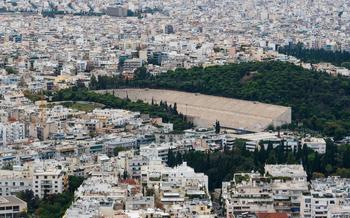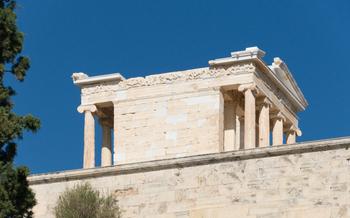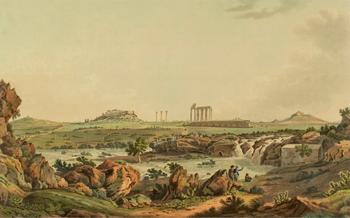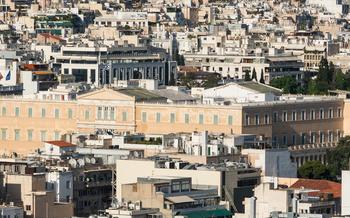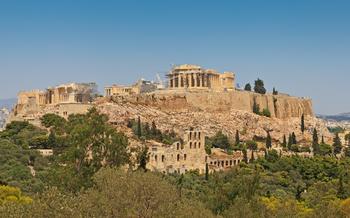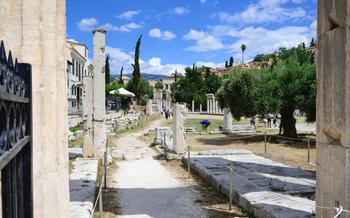
Foundation of the Hellenic World
- Acropolis Museum
- Ancient Agora
- National Archaeological Museum
- Temple of Zeus Olympios: A Testament to Ancient Grandeur
- Panathenaic Stadium
- Benaki Museum
- Museum of Cycladic Art
- Byzantine and Christian Museum
- National Historical Museum
- War Museum
- Jewish Museum of Greece
- Stavros Niarchos Foundation Cultural Center
- A Contemporary Gem on the Athenian Waterfront
- Insider Tip: Unveiling Athens' Hidden Gems
Acropolis Museum
The Acropolis Museum, a beacon of Greek history and culture, stands majestically on the slopes of the sacred Acropolis hill. Its striking glass and concrete structure, designed by Swiss architect Bernard Tschumi, seamlessly blends with the ancient surroundings, creating a harmonious dialogue between the past and present.
Within its walls, the museum houses a treasure trove of artifacts that narrate the compelling story of the Acropolis, from its inception to its enduring legacy. Among the must-see exhibits are the Caryatids, graceful female figures that once adorned the Erechtheion temple, and the Parthenon sculptures, exquisite masterpieces that once graced the Parthenon's pediments and metopes. These iconic works of art, meticulously crafted from Pentelic marble, embody the pinnacle of ancient Greek artistry.
To fully immerse yourself in the museum's offerings, plan your visit carefully. Arrive early to avoid crowds and take your time to explore the various galleries. Utilize the museum's excellent audio guide, which provides insightful commentary on the exhibits, bringing the ancient world to life. And don't miss the opportunity to visit the rooftop restaurant, where you can savor delectable Greek cuisine while enjoying breathtaking views of the Acropolis.
Ancient Agora
The Ancient Agora, once the bustling heart of ancient Athens, offers a glimpse into the city's vibrant past. This 5th-century BC marketplace and civic center was where democracy was born, where philosophers debated, and where everyday Athenians went about their daily lives.
Historical Significance:
- The Agora served as the political, commercial, and social hub of ancient Athens.
- It was the birthplace of democracy, where the Athenian Assembly, or Ecclesia, met to make decisions.
- Famous philosophers like Socrates, Plato, and Aristotle engaged in discussions and taught their students in the Agora.
Key Structures to Explore:
- Stoa of Attalos: A beautifully preserved stoa, or covered walkway, that has been restored to its former glory.
- Temple of Hephaestus: One of the best-preserved ancient Greek temples, dedicated to the god of metalworking and fire.
- Bouleuterion: The meeting place of the Boule, or Council of Five Hundred, which oversaw the day-to-day running of the city.
Recommendations for an Enriching Visit:
- Explore the Museum of the Ancient Agora: This on-site museum houses artifacts found during excavations, providing context and insights into the Agora's history.
- Join a Guided Tour: Guided tours are available to delve deeper into the stories and significance of the various structures and monuments.
- Visit at Sunset: As the sun sets, the Agora takes on a magical ambiance, casting long shadows and creating a serene atmosphere.
National Archaeological Museum
The National Archaeological Museum in Athens is a treasure trove of ancient Greek artifacts, housing one of the world's most comprehensive collections of antiquities. Established in 1829, the museum has been instrumental in preserving and showcasing Greece's rich cultural heritage.
The museum's vast collection spans from the Neolithic period to the Roman era, offering a glimpse into the development of ancient Greek art and civilization. Highlights include the Minoan frescoes from Akrotiri, depicting vibrant scenes of daily life on the island of Thera (Santorini), and the Mycenaean gold jewelry from the royal tombs of Mycenae, showcasing the exquisite craftsmanship of the Bronze Age.
For an enriching visit, take advantage of the free guided tours offered by the museum. These tours provide insightful commentary and historical context, helping you understand the significance of the artifacts and their role in shaping Greek history.
Remember to plan at least 2-3 hours for your visit, as the museum's extensive collection requires ample time to appreciate fully. Additionally, comfortable shoes are recommended, as you'll be doing a lot of walking through the spacious galleries.
Temple of Zeus Olympios: A Testament to Ancient Grandeur
A journey to Athens, the cradle of Western civilization, is incomplete without a visit to the awe-inspiring Temple of Zeus Olympios, an architectural marvel that stands as a testament to the grandeur and devotion of ancient Greeks. Constructed over several centuries, this colossal temple was dedicated to Zeus, the king of the gods in Greek mythology.
The temple's massive columns, each towering over 17 meters, exude an aura of strength and resilience. Originally adorned with intricate sculptures and shimmering gold, the temple was a sight to behold, capturing the essence of ancient Greek artistry and religious fervor.
Enter the temple grounds and immerse yourself in the rich history and mythology that surround this sacred site. Let your imagination wander as you envision the grand religious ceremonies and festivals that once took place here, honoring the almighty Zeus and seeking his favor.
Beyond its architectural significance, the Temple of Zeus Olympios holds a profound place in Greek mythology. It was here, according to legend, that Zeus hurled his thunderbolts, demonstrating his power and authority over the cosmos.
To fully appreciate the temple's grandeur, take your time to explore the surrounding archaeological site, where remnants of ancient structures and artifacts await discovery. Engage with the informative signage and immerse yourself in the stories of the people who once worshipped here.
As you stand amidst the ruins of this magnificent temple, let the spirit of ancient Greece come alive. Feel the awe and wonder that the ancients experienced as they paid homage to their gods and celebrated the wonders of life.
Panathenaic Stadium
The Panathenaic Stadium, also known as the Kallimarmaro, is a magnificent architectural marvel that holds a prominent place in Greek history and culture. Built entirely of white marble in the 4th century BC, it was designed to host the Panathenaic Games, a grand athletic and cultural festival held in honor of the goddess Athena, patron deity of Athens.
Historical Significance
The Panathenaic Stadium was more than just a sports venue; it was a symbol of Athenian power and prestige. The games, held every four years, attracted athletes and spectators from all over the ancient world. The stadium's unique horseshoe shape allowed for an unobstructed view of the competitions from all angles, creating an immersive and awe-inspiring experience for the spectators.
Architectural Features and Renovations
The Panathenaic Stadium's design showcased the architectural prowess of the ancient Greeks. Its tiered seating, supported by elegant marble columns, could accommodate up to 50,000 spectators. The stadium underwent extensive renovations in the late 19th century to prepare it for the revival of the Olympic Games in 189These renovations, overseen by renowned Greek architect Anastasios Metaxas, restored the stadium to its former glory while incorporating modern elements to ensure its functionality.
Tips for Exploring the Stadium
To fully appreciate the grandeur of the Panathenaic Stadium, visitors are recommended to take a guided tour. Knowledgeable guides provide insights into the stadium's history, architecture, and significance. Visitors can also explore the stadium's museum, which houses artifacts related to the ancient Olympic Games and the stadium's renovation.
For a truly immersive experience, visitors can attend a concert or sporting event held at the stadium. The acoustics are exceptional, and the atmosphere is electric as the ancient marble seats echo with the sounds of music or the roar of the crowd.
Benaki Museum
The Benaki Museum stands as a testament to the rich artistic and cultural heritage of Greece, spanning from antiquity to the present day. Housed in a magnificent neoclassical mansion, the museum's diverse collection encompasses over 40,000 artifacts, each narrating a unique chapter in the nation's captivating history.
Among the highlights of the permanent exhibition are exquisite ancient Greek sculptures, intricate Byzantine mosaics, and breathtaking Islamic pottery. The museum also boasts an impressive collection of modern and contemporary Greek art, showcasing the works of renowned artists such as Nikos Hadjikyriakos-Ghikas, Yannis Moralis, and Vlassis Caniaris.
To fully appreciate the museum's treasures, take advantage of the informative guided tours, which delve into the historical and cultural significance of the exhibits. Don't miss the temporary exhibitions, which often feature thought-provoking and cutting-edge contemporary art.
When planning your visit, allow ample time to explore the museum's various galleries and courtyards. The Benaki Museum offers a unique opportunity to immerse yourself in the diverse artistic expressions that have shaped Greece's rich cultural tapestry.
Museum of Cycladic Art
The Museum of Cycladic Art unveils the enigmatic world of the Cycladic civilization, an ancient society that flourished in the Aegean Sea from 3300 to 2000 BC. This captivating museum houses a remarkable collection of Cycladic figurines and artifacts, inviting visitors on a journey through time to discover the artistry and beliefs of this mysterious culture.
Among the museum's highlights are the renowned Cycladic figurines, crafted from pure white marble with their distinctive abstract forms and enigmatic smiles. These exquisite sculptures offer a glimpse into the religious and funerary practices of the Cycladic people, symbolizing fertility, protection, and the afterlife.
To fully appreciate the museum's treasures, take advantage of their insightful audio guide, providing detailed explanations and historical context for each exhibit. Immerse yourself in the allure of the Cycladic civilization by exploring the museum's temporary exhibitions, which often showcase significant archaeological discoveries and shed light on various aspects of Cycladic life and culture.
Plan your visit during the museum's extended hours on Thursdays and take advantage of their free admission on the first Sunday of each month. The museum also offers educational programs, workshops, and family-friendly activities, making it an ideal destination for visitors of all ages seeking to delve into the captivating world of Cycladic art and culture.
Byzantine and Christian Museum
The Byzantine and Christian Museum houses a remarkable collection of artifacts that delve into the rich artistic and religious heritage of Greece and the broader Byzantine Empire. Located in a beautifully restored 19th-century mansion, the museum takes visitors on a journey through the evolution of Byzantine and post-Byzantine art, spanning approximately two millennia.
Key Artifacts and Their Historical Significance:
-
Byzantine Icons: Admire the exquisite collection of icons, which embody the Byzantine aesthetic and theological expressions. These painted panels often depict religious figures and scenes and offer a glimpse into the deep devotion and artistry of the Byzantine period.
-
Mosaics: Intricate mosaics adorn the walls and floors of the museum, showcasing the technical prowess and aesthetic refinement of Byzantine craftsmen. These mosaics depict a range of subjects, from religious scenes to everyday life, providing valuable insights into the Byzantine worldview.
-
Manuscripts: The museum houses a significant collection of illuminated manuscripts, which are adorned with elaborate illustrations and calligraphy. These manuscripts, ranging from religious texts to historical chronicles, offer a glimpse into the literary and künstlerisch achievements of the Byzantine and post-Byzantine periods.
Tips for a Meaningful Visit:
-
Guided Tours: Consider joining a guided tour to gain in-depth knowledge about the exhibits and their historical context. Tours are available in various languages and provide a structured and informative experience.
-
Explore the Temporary Exhibitions: The museum regularly hosts temporary exhibitions that showcase specific themes or artists. These exhibitions offer a fresh perspective on Byzantine and Christian art and provide an opportunity to delve deeper into specific aspects of the collection.
-
Combine with Other Museums: To fully appreciate the artistic and historical context of the Byzantine and Christian Museum, consider visiting other museums in Athens, such as the Benaki Museum or the National Archaeological Museum. These institutions offer complementary perspectives on ancient Greek, Byzantine, and post-Byzantine art and history.
National Historical Museum
Journey back in time to explore Greece's rich and multifaceted history at the National Historical Museum. Housed in the stately Old Parliament Building, this museum offers a comprehensive narrative of Greece's evolution from the fall of the Byzantine Empire in the 15th century to the establishment of the modern Greek state in the 19th century.
Marvel at a vast collection of artifacts that bring to life the nation's struggles for independence, political transformations, and cultural achievements. Among the highlights are personal belongings of prominent historical figures, such as Theodoros Kolokotronis and Ioannis Kapodistrias, as well as rare documents, paintings, and sculptures that capture pivotal moments in Greece's journey towards nationhood.
To make the most of your visit, plan a route that aligns with your interests. If you're fascinated by the Greek War of Independence, don't miss the exhibits showcasing weapons, uniforms, and manuscripts that tell the stories of the brave men and women who fought for freedom. Alternatively, if you're drawn to modern Greek history, delve into the sections dedicated to the Balkan Wars, the Asia Minor Catastrophe, and the rise of democracy in Greece.
Remember to allocate ample time for your visit, as the museum's extensive collection invites thorough exploration. Allow yourself to be immersed in the narratives of Greece's past, and gain a deeper appreciation for the forces that have shaped this remarkable nation.
War Museum
The War Museum stands as a testament to Greece's resilience and sacrifices throughout its military history. Its exhibits offer a comprehensive overview of Greece's involvement in conflicts from the Balkan Wars to World War II. Through captivating displays, visitors can delve into the nation's struggles for independence, witness the horrors of war, and honor the bravery of Greek soldiers.
Among the museum's highlights are the poignant personal stories of Greek soldiers and civilians who fought and suffered during these turbulent times. These accounts, often accompanied by photographs and artifacts, bring a deeply human dimension to the exhibits, allowing visitors to connect with the individuals whose lives were forever marked by war.
To fully appreciate the museum's significance, visitors are encouraged to take their time exploring the various sections, which include displays on the Balkan Wars, World War I, the Asia Minor Campaign, and World War II. Each section offers a unique perspective on Greece's military history, shedding light on the challenges and triumphs faced by the nation.
The War Museum serves as a powerful reminder of the devastating impact of war and the importance of peace. It is a place where visitors can learn from the past, honor the sacrifices of those who fought for Greece's freedom, and reflect on the enduring legacy of war.
Jewish Museum of Greece
Buried in the heart of the old Jewish quarter, the Jewish Museum of Greece is a moving testament to the vibrant history and culture of the Jewish community in Greece. Founded in 1977, the museum showcases a diverse collection of artifacts, photographs, and documents that narrate the journey of Greek Jews from antiquity to the present day.
As you step into the museum, you'll be greeted by a poignant memorial to the victims of the Holocaust, a stark reminder of the tragic events that unfolded during World War II. The museum's exhibits then delve into the rich tapestry of Jewish life in Greece, shedding light on their traditions, customs, and contributions to Greek society.
Among the highlights of the collection are intricately decorated Torah scrolls, ceremonial objects, and textiles that showcase the artistic prowess of Jewish artisans. You'll also find fascinating documents that chronicle the community's involvement in trade, politics, and the arts throughout the centuries.
The museum also pays homage to the vibrant Jewish community that once thrived in Thessaloniki, the city that was once home to the largest Jewish population in Greece. Through photographs and personal accounts, you'll learn about their vibrant culture, their contributions to the city's economy, and the tragic events that led to their decimation during World War II.
A visit to the Jewish Museum of Greece is a profound experience that offers a glimpse into the resilience and spirit of the Jewish community in Greece. It's a place to remember, to learn, and to celebrate the enduring legacy of a people who have played an integral role in shaping the cultural fabric of Greece.
Stavros Niarchos Foundation Cultural Center
A Contemporary Gem on the Athenian Waterfront
The Stavros Niarchos Foundation Cultural Center (SNFCC) is a striking architectural marvel and cultural hub located in the heart of Athens, Greece. Designed by world-renowned architect Renzo Piano, the center epitomizes modern elegance and sustainability while seamlessly blending with the city's historic surroundings.
The SNFCC is a vibrant complex that houses the National Library of Greece, the Greek National Opera, the Stavros Niarchos Park, and various educational and cultural institutions. The National Library, with its impressive collection of over four million books and manuscripts, offers a serene space for research and study. The Greek National Opera, renowned for its world-class performances, stages captivating productions in its state-of-the-art theater.
Architectural enthusiasts will marvel at the SNFCC's design, characterized by its sweeping curves, glass facades, and innovative use of natural light. The complex is adorned with lush gardens, reflecting pools, and outdoor spaces that invite visitors to relax and soak in the stunning views of the city skyline and the Saronic Gulf.
Beyond its architectural beauty, the SNFCC is a hub for cultural events, exhibitions, concerts, workshops, and educational programs. Throughout the year, the center hosts a diverse range of activities that cater to all ages and interests, making it a vibrant gathering place for locals and tourists alike.
Plan a visit to the Stavros Niarchos Foundation Cultural Center to experience its unique blend of culture, architecture, and natural beauty. Immerse yourself in the world of literature at the National Library, enjoy a captivating performance at the Greek National Opera, or simply stroll through the serene park, taking in the breathtaking views. The SNFCC is a true gem that showcases the modern face of Athens while honoring its rich cultural heritage.
Insider Tip: Unveiling Athens' Hidden Gems
Beyond the renowned landmarks, Athens is a treasure trove of hidden gems waiting to be discovered. Escape the tourist crowds and venture into the heart of the city to uncover its lesser-known wonders. For a truly immersive experience, seek out the charming neighborhood of Anafiotika, nestled on the slopes of the Acropolis. Wander through its labyrinthine cobblestone streets, admire the whitewashed houses adorned with colorful bougainvillea, and soak in the tranquil atmosphere.
Take a break from the bustling city center and find solace in the National Garden, an oasis of serenity just a stone's throw from Syntagma Square. Stroll along its shaded paths, marvel at the botanical wonders, and escape the urban hustle and bustle.
For a taste of authentic Athens, head to the vibrant Central Market, a culinary paradise where locals shop for fresh produce, spices, and traditional delicacies. Indulge in mouthwatering street food, savor the aromas of freshly baked pastries, and immerse yourself in the lively atmosphere.
To witness a breathtaking sunset, make your way to Philopappos Hill, a tranquil haven offering panoramic views of the city. As the sun dips below the horizon, the sky transforms into a canvas of vibrant hues, creating a magical spectacle not to be missed.
For a unique perspective of Athens, embark on a scenic bike ride along the picturesque coastline. Pedal your way through scenic neighborhoods, discover hidden coves, and enjoy a refreshing dip in the crystal-clear waters of the Saronic Gulf.



